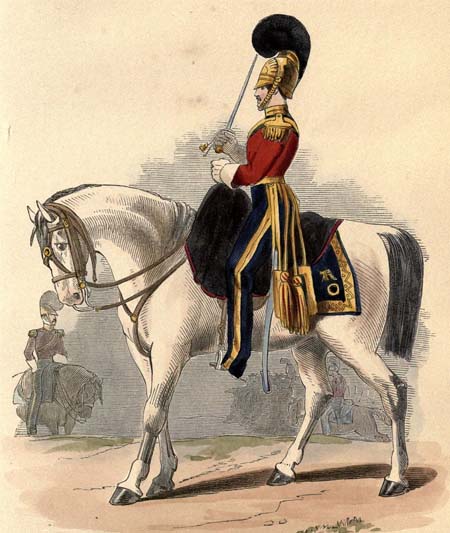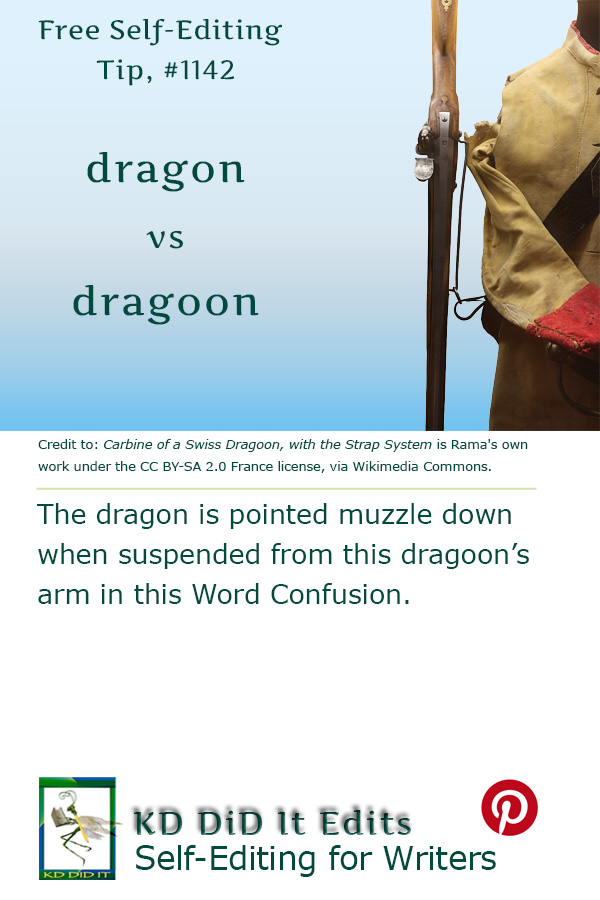I was reading and came across dragon and got to wondering the difference between dragon and dragoon.
I was shocked. Shocked, I tell you. The Internet was pretty accurate in what popped up in searches.
It turns out that European dragons were depicted as fire-breathers, and when the blunderbuss was shortened to make it easier for mounted infantry to carry and use a gun, they were named dragons for the smoke that rose from the muzzle.
The name of the gun provided the nickname for the troops who used the dragons, and those soldiers became the dragoons.
Word Confusions . . .
. . . started as my way of dealing with a professional frustration with properly spelled words that were out of context in manuscripts I was editing as well as books I was reviewing. It evolved into a sharing of information with y’all. I’m hoping you’ll share with us words that have been a bête noire for you from either end.
If you found this post on “Dragon versus Dragoon” interesting, consider subscribing to KD Did It, if you’d like to track this post for future updates.
| Dragon | Dragoon |
|---|---|

Dragon on the Dragon Bridge, Ljubljana, Slovenia, is Petar Milošević‘s own work under the CC BY-SA 4.0 license, via Wikimedia Commons. |

1st Royal Dragoons Uniform, p 116, 1839, Historical Record of the First, or the Royal Regiment of Dragoons. Longman, Orme, and Co., London: 1840, via Wikimedia Commons. |
| Part of Grammar: | |
| Noun
Feminine version: dragoness Plural: dragons, dragonesses |
Noun; Verb, transitive
Plural for the noun: dragoons Third person present verb: dragoons |
A mythical monster traditionally represented as a gigantic reptile having a long tail, sharp claws, scaly skin, and often wings
[Also flying dragon] Another term for flying lizard
[Bible] A large animal, possibly a large snake or crocodile [Historical; in the 16th and 17th centuries] A short musket carried on the belt of a soldier, especially a mounted infantryman
[Plants] Any of various North American aroid plants [Ecclesiastical; Christianity] A manifestation of Satan or an attendant devil [Sailing] A yacht of the International Dragon Class, 8.88m long (29.2 feet), used in racing [Recreational drugs; slang] To smoke opium or heroin [Astronomy; initial cap] The constellation Draco |
Noun: [Military] A member of a unit of cavalry, originally mounted infantry armed with short muskets, of a type common in European armies from c1600 to World War I
[Plural noun; initial cap when part of a name] The Royal Dragoons [Animals; sometimes capitalized] A domestic fancy pigeon Verb, transitive:
To subjugate or persecute by the imposition of troops |
| Examples: | |
| In European tradition the dragon is typically fire-breathing and came to symbolize chaos or evil, whereas in East Asia it is usually a beneficent symbol of fertility, associated with water and the heavens.
Dragons are a mythical creature found in many folktales throughout the world. The geography teacher was a real dragon. Be careful of the dragonlady! Your governess is a real dragon. “Draco lizards use their long, slender tails to steer themselves, and each sortie can carry them up to 30 feet” (DracoLiz). “Shai Meiri, a herpetologist at Tel Aviv University, has previously shown that many dragon lizards live in small, hard-to-access areas, making the reptiles difficult to study” (Rochmyaningsih). Easily handled while mounted, a dragon is a shorter version of the blunderbuss (Dragon). A dragoon would be issued a dragon to be carried on his belt. “The dragon tree is the slowest of growth among vegetables; it seems also to be slowest in decay” (Graham). A perennial herb, Arisaema dracontium, more commonly known as green dragon, dragonroot, and greendragon, can be toxic although it is deer resistant (Arisaema). Dragons are primarily symbolic metaphors used in the Bible to describe sea monsters, serpents, sinister cosmic forces, and even Satan” (Fairchild). “The defending Yacht Club Compagnia della Vela of Venice has chosen the Dragon again as the class in which to sail this historic competition” (Pearson). Paul’s not here. He’s out chasing the dragon. “The biblical dragon of Revelation, “the old serpent”, was many-headed like the Greek Hydra” (Duignan). Draco “was one of the 48 constellations listed by the 2nd century astronomer Ptolemy, and remains one of the 88 modern constellations today” (Draco). |
Noun: Dragons were typically issued to dragoon cavalry, who needed a lightweight, easily handled firearm while mounted” (Dragon). The Royal Dragoons, a.k.a. 1st Dragoons, was formed in 1661 as the Tangier Horse and saw action during the First and the Second World Wars (1st). “The King’s Own Royal Regiment of Dragoons was named for Charles II” (1st). Dragoon pigeons were one of the pigeon breeds used in the development of the Racing Homer pigeon (Staff). Verb, transitive: He was dragooned into admitting it. He had been dragooned into the excursion. |
| Derivatives: | |
| Adjective: dragonish, dragonlike Noun: dragonet, dragonnade |
|
| History of the Word: | |
| Middle English, also denoting a large serpent, is from the Old French, via the Latin dracō, dracōn- meaning large serpent, from the Greek drakōn. | Early 17th century, denoting a kind of carbine or musket, thought of as breathing fire, is from the French dragon meaning dragon. |
C’mon, get it out of your system, bitch, whine, moan . . . which words are your pet peeves? Also, please note that I try to be as accurate as I can, but mistakes happen or I miss something. Email me if you find errors, so I can fix them . . . and we’ll all benefit!
Satisfy your curiosity about other Word Confusions on its homepage or more generally explore the index of self-editing posts. You may also want to explore Book Layout & Formatting Ideas, Formatting Tips, Grammar Explanations, Linguistics, Publishing Tips, the Properly Punctuated, Writing Ideas and Resources, and Working Your Website.
Resources for Dragon versus Dragoon
Some of these links may be affiliate links, and I will earn a small percentage, if you should buy it. It does not affect the price you pay.
“1st The Royal Dragoons.” Wikipedia. 27 Dec 2022. Web. 11 Jan 2023. <https://en.wikipedia.org/wiki/1st_The_Royal_Dragoons>.
Apple Dictionary.com
“Arisaema dracontium.” Plant Database. University of Texas-Austin. 23 Nov 2022. Web. 11 Jan 2023. <https://www.wildflower.org/plants/result.php?id_plant=ardr3>.
Dictionary.com: dragon
“Draco.” Wikipedia.com. 25 Dec 2022. Web. 11 Jan 2023. <https://en.wikipedia.org/wiki/Draco_(constellation)>.
“Draco Lizard.” Reference. Animals. National Geographic.com. n.d. Web. 11 Jan 2023. <https://www.nationalgeographic.com/animals/reptiles/facts/draco-lizard>.
“Dragon (firearm).” Wikipedia.com. 12 July 2022. Web. 11 Jan 2023. <https://en.wikipedia.org/wiki/Dragon_(firearm)>.
Duignan, Brian. The Editors of Encyclopedia Britannica. “Dragon: Mythological creature.” Encyclopedia Britannica. n.d. Web. 11 Jan 2023. <https://www.britannica.com/topic/dragon-mythological-creature>.
Dumas, Alexandre. Twenty Years After. Collins’ Clear-Type Press, Scotland: 1845. 2020. <https://amzn.to/3W4Dk1H>.
Fairchild, Mary. “Are There Dragons in the Bible?” Christianity. Middle Eastern. Abrahamic. Learn Religions. 27 May 2021. Web. 11 Jan 2023. <https://www.learnreligions.com/are-there-dragons-in-the-bible-5181660>.
The Free Dictionary: dragon, dragoon
Graham, Maria. Journal of a Voyage to Brazil. Project Gutenberg: 2007. <https://www.gutenberg.org/files/21201/21201-h/21201-h.htm>.
Pearson, Tim. “Marblehead Trophy 16 – 18 June 2023.” International Dragon Sailing.net. 31 Dec 2022. Web. 11 Jan 2023. <https://internationaldragonsailing.net/marblehead-trophy-16-18-june-2023/>.
Rochmyaningsih, Dyna. “A Nose-horned Dragon Lizard Lost to Science For Over 100 Years Has Been Found.” ScienceNews. 9 June 2020. Web. 11 Jan 2023. <https://www.sciencenews.org/article/nose-horned-dragon-lizard-lost-science-found>.
Staff. “Dragoon Pigeon Characteristics, Origin & Uses.” Roy’s Farm. 2 Sept 2022. Web. 11 Jan 2023. <https://www.roysfarm.com/dragoon-pigeon/>.
Pinterest Photo Credits:
Carbine of a Swiss Dragoon, with the Strap System is Rama‘s own work under the CC BY-SA 2.0 France license, via Wikimedia Commons.


